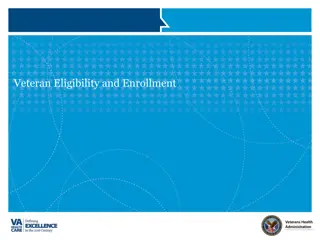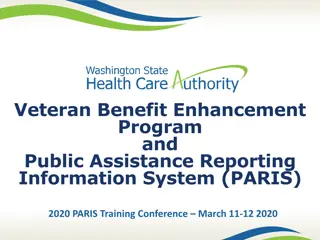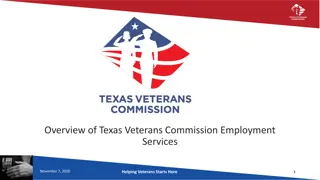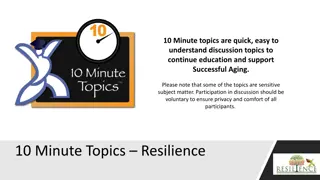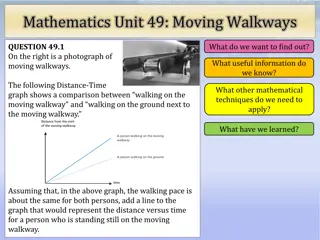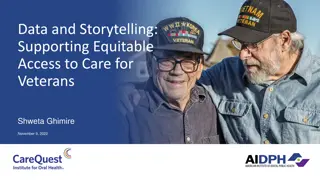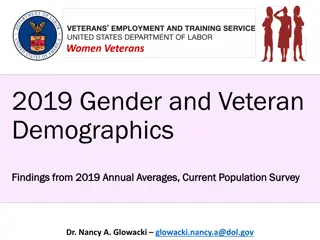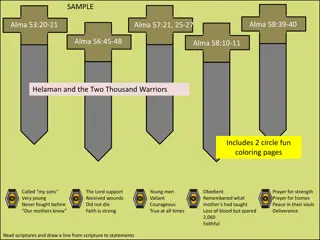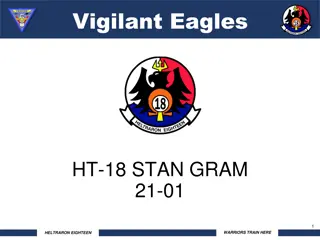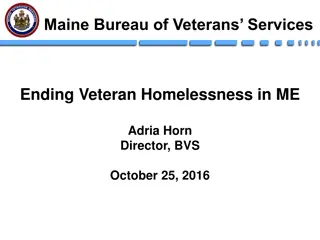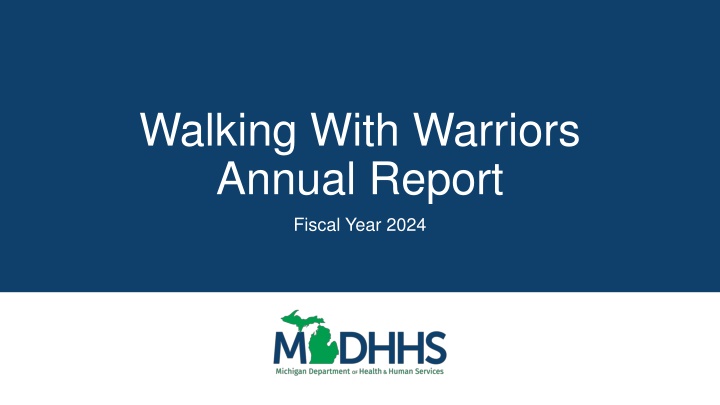
Empowering Veterans and Military Families: Walking with Warriors Program Overview
Providing mental health and substance abuse resources, the Walking with Warriors program aims to lower stigma, decrease suicides, and promote self-advocacy for Veterans and Military families. Their vision is to create a sustainable program enhancing behavioral health care services with a mobile best practice model. By safeguarding, respecting, and encouraging wellbeing, they collaborate with stakeholders to meet comprehensive needs while supporting self-sufficiency. Successes include specialized training programs and robust partnerships with Veteran Health Administration entities.
Download Presentation

Please find below an Image/Link to download the presentation.
The content on the website is provided AS IS for your information and personal use only. It may not be sold, licensed, or shared on other websites without obtaining consent from the author. If you encounter any issues during the download, it is possible that the publisher has removed the file from their server.
You are allowed to download the files provided on this website for personal or commercial use, subject to the condition that they are used lawfully. All files are the property of their respective owners.
The content on the website is provided AS IS for your information and personal use only. It may not be sold, licensed, or shared on other websites without obtaining consent from the author.
E N D
Presentation Transcript
Walking With Warriors Annual Report Fiscal Year 2024
MDHHS/Behavioral and Physical Health and Aging Services Administration (BPHASA) Veteran and Military Family Strategic Plan and Objectives Walking with Warriors Project
Our mission is to identify, engage and connect Veterans and Military families to mental health and substance abuse resources. This approach has shown to lower stigma, decrease suicides and promote self-advocacy. Mission
To create an effective and sustainable program that increases capacity in the publicly-funded behavioral health care system. To encourage a proactive approach to the delivery of behavioral health services to Veterans and Military families with a best practice model that is mobile and easily replicated. Vision
Safeguard, respect and encourage the wellbeing of Veterans and Military families. Collaborate and coordinate with state and local stakeholders to meet the comprehensive needs of Veterans and Military families. Continue to foster relationships with federal and VA entities. Support Veterans and Military families on their road to self-sufficiency. Values
MDHHS Regional Prepaid Inpatient Health Plans Effective January 1, 2014
Nine Prepaid Inpatient Health Plans (PIHP) Regional Veteran Navigator positions full; 15 Community Mental Health (CMH) Veteran Navigators that cover 21 counties; and four Veteran Peer Support Specialists. Four Veteran ReEntry Care Coordinators Walking with Warriors Program Successes Health & Wellness Program: Designed to train our team in specific focused areas every year and provide an opportunity for them to build their resilience. THRIVE Training: A resilience/suicide prevention community centric approach to Veteran and family care continues to expand and grow with trainings doubled next year due to external funding.
Ongoing robust relationships with all five Veteran Health Administration (VHA). Walking with Warriors Program Successes Overall success throughout our project: Over 40,000 Veterans and Military families engaged with since November of 2016. Veterans more likely to reach out for help 75%. Veterans engaging in social activities that positively affect their health has increased 12% this year from 66% to 78%.
FY23 Veterans and Military Families Identified 6,954. Previously Unidentified Veterans and Military Families for Mental Health and Substance Use Disorder Treatment FY24 Veterans and Military Families Identified to date 9,257. Events/phone/email connections were an additional 11,213 not included in the above data with about 10% referred for MH/SUD services.
Housing Instability. Gambling. Substance Use. Depression. PTSD. Food Insecurity. Military Service. Social Determinants of Health for Veterans
Snapshot of Demographics of Veterans Reached Male 5,966 Female 3,391
Army 3,598 Navy 2,679 Snapshot of Demographics of Veterans Reached Air Force 1,961 Marines 974 Coast Guard 45
Honorable 5,169 General/Honorable 1,971 Snapshot of Demographics of Veterans Reached Medical 1,728 Other Than Honorable 296 Dishonorable 93
Three (3) largest demographics: Veteran Eras Most Identified for Mental Health/Substance Use Disorder Treatment and Referral Vietnam Veterans: 2,919 Operation Iraqi Freedom/Operation Enduring Freedom Veterans: 2,321 Desert Storm Veterans: 1,212
Four (4) largest challenges: Veteran and Military Family Mental Health/Substance Use Disorder Primary Challenges SUD - Alcohol 3,321 PTSD 2,304 Depression/Anxiety 2,379 SUD - Opioids 693
Medicaid/Medicare: 2,064 Veterans Health Administration (VHA): 4,037 No Medicaid/No Insurance: 1,588 Veteran Insurance Coverage Private No Medicaid/No Insurance: 465
Community Mental Health/SUD Providers 57%. Veterans Affairs (VHA, VBA) CBOCs, Local County VAs 78%. Only 40% of eligible Veterans are accessing their VA benefits nationwide. Housing 82% (This demonstrates the increases we have identified over the past 18 months). Employment 18%. Education 10%. Transportation 40%. Veteran Service Officer 50%. Legal/Veteran Court 25%. Growing Referrals Faith 6% and Food 25%. Where are We Referring Newly Identified Veterans and Military Families?
Connecting Our Veterans to Their Benefits Since 2018, we have been aggregating data on Veteran Service Connection Disability increases to demonstrate that our program is reaching those Veterans most at need of resources to improve their quality of life. Contact was initiated by Veteran Navigator. Veteran Service Connection increases for all Veterans since 2018. Veteran Service Connection Disability Federal Funds coming into Michigan since 2018 $30,598,327. Most information gathered directly from Veteran or family member.
Individual reports being better equipped to function effectively in community. = 74%. Individual reports greater willingness to reach out for help. = 72%. Survey Results Do you have an increased awareness or knowledge of Veteran programs and/or benefits you are eligible for? = 73%.
Contact Information Walking With Warriors Veteran Navigator Contact Info: Brian Webb: MDHHS/BPHASA Veteran Liaison, WebbB3@Michigan.gov Brenda Stoneburner: CPI Section Manager, StoneburnerB@Michigan.gov



